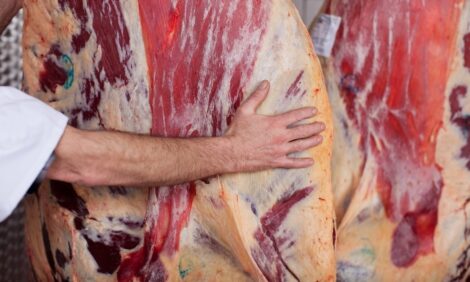



NADIS Cattle Veterinary Report and Forecast - August 2007
UK - This is a monthly report from the National Animal Disease Information Service (NADIS), looking at the data collected from their UK farm inspections.2007 will go down as one of the worst summers for weather with a wet July following the wet June. England and Wales recorded almost twice the average rainfall with some areas seeing four times the average. The return of FMD to Surrey and the subsequent impact on livestock movement across the UK has just capped a bad summer. We will know the impact of the outbreak of FMD on vet activity next month; this NADIS report looks at the NADIS vet reports during July.
ADULT
Metabolic diseaseThe number of displaced abomasums (DAs) reported in July decreased slightly compared to June, but remained significantly above the long term average. Nevertheless, the NADIS data suggest that by year end there will have been between 640 and 660 cases of DA reported, lower than in any year since 2001. Are we beginning to see a downward trend? If so is this because preventative measures are finally being put in place or was the high prevalence in the past five years a statistical blip similar to that reported by Roger Eddy in the early 1980’s?
Figure 1: Number of monthly reports of DA in 2007 and 2006 compared to mean of 1997-2005.
Displaced Abomasum - Dairy Cattle
The number of acetonaemia reports rose appreciably in July to the average, so it’s still unclear as to why reports were so low in April and, particularly, May
The number of milk fever reports, rose considerably in July, reaching, for the first time this year, the long term average. So far this year the number of milk fever reports has been lower than any previous year except for 2001. Indeed the NADIS figures suggest that at the end of the year there will have been between 430 and 470 reports of milk fever, well down on other years, including 2001. Thoughts as to why this is the case would be gratefully received. Milk fever remains a significant problem on many farms so its prevention is likely to remain a major veterinary role. If vets are not involved in milk fever treatment and control then both economics and animal health will be suffering. There is always a positive spin that there is less veterinary involvement because we have the disease under control, this is partially supported by the slow and relatively consistent decline in cases seen since 1997. We need more data!
Figure 2: Total yearly reports for milk fever from 1997 to 2006 with estimated results for 2007
The number of downer cows fell further in July to the lowest number of reports for any month in any year. The NADIS data show that after five years of a significant trend upwards we have seen a dramatic drop in reports since the peak in 2004. Such a trend cannot reflect what is actually happening on the ground, but reflects economic trends. Undoubtedly much of the drop is due to the loss of the OTMS, which compensated farmers with down cows, provided they got a veterinary visit. This has been replaced by more stringent BSE testing for older cattle so down cows are now a disposal cost rather than an asset. However, interestingly the decline in the number of reports of downer cows began in 2005 before the end of the OTMS, so it’s unlikely its demise was the sole cause of the drop. Even so the NADIS data suggest that there has been a substantial drop in the involvement of veterinarians with the downer cow which may have major impacts on individual animal welfare. This needs investigation.
Figure 3: Mean monthly reports of downer cows from 1997 to 2007, showing the dramatic drop in reports in recent years.
Mastitis
There were very few cases of summer mastitis in July, which, as July cases are negatively correlated to those in August (see Figure 4), suggests that this August will be a bad month with reports up to 33% greater than average. The FMD outbreak is likely to reduce this figure increasing the need to be vigilant. We need better preventative strategies. Teat sealants seem to be a logical choice for preventing summer mastitis, however there is a lack of published evidence of how effective they are. We would be very interested to hear any reports of their use.
Figure 4: Comparison of summer mastitis reports in July with those in August for the years 1997 to 2007 showing that low numbers of reports in July are closely linked to high numbers in August.
Fly control is an important part of summer mastitis control, however particularly in severely affected areas fly control can be difficult to achieve. In June, a Glamorgan vet reported that several of his clients are using a garlic laced lick to help keep off flies and finding it very effective. Does anyone else have an effective alternative to insecticides?
Fertility
Both the number of reports of missed heats and anoestrus cows followed the usual seasonal trend downwards in July. However in both cases the reduction was greater than normal so that figures were well below average. The figures for these two conditions, particularly the former, suggest that veterinary input on farm is decreasing with the 2007 figures being lower than any year except for 2001. The recent FMD outbreak is unlikely to change this.
Figure 5: Number of reports of non-detected oestrus showing the relatively consistent nature of reporting totals since 1997, and the low level of reports so far this year (and the low predicted number)
The number of uterine torsions declined in July, falling below the long term average.. This condition like DA has been linked to large cows with large volumes of abdominal space, and like DA has been seen at higher levels recently. Again like DA cases, 2007 has seen a fall from a peak back towards the long term average.
Figure 6: Change in yearly reports of uterine torsion (with predicted number for 2007)
Lameness
Overall the number of reports of lameness decreased in July. However of the 4 main diseases only reports of solar ulcer were lower July than June, mirroring the usual seasonal trend. The number of cases of digital dermatitis and white line disease followed their usual seasonal trend of flat or slight increase. Thus for these diseases there is no evidence, as yet, of an impact of the high rainfall. The peak in white line disease is September and October so it is likely that the weather coming up to this period will be more important than current conditions. In contrast to the other three diseases there is an unseasonable but small increase in foul-in-the-foot cases, suggesting a link to the increased rainfall. It is likely that the improved weather this month will have reversed this trend.
Figure 7: Trends in monthly reports of foul-in-the-foot 2006 and 2007 compared to the average of 1997 to 2005
Foul of the Foot - All Cattle
Other diseases
The high number of New Forest Eye reports in May suggested that this summer looked likely to be a bad one for this condition, however the wet weather in June and July appears to have resulted in a relatively good year for New Forest Eye with fewer affected cattle and less use of antibiotics. The bovine iritis season has finished with fewer cases than normal, suggesting that we’re getting better management of this disease or that farmers are controlling it without veterinary help.
Figure 8: Comparison of 2007 figures for silage eye with average for 2004 to 2006.
CALVES
July tends to be one of the lowest months for reporting most calf diseases, so even though disease reports have been rare this year it is not surprising that July saw further falls in reports of joint ill, calf scour and pneumonia. It will be interesting to see the impact of FMD on this figure as the increased crowding resulting from movement restrictions may increase the risk of disease spread.July saw a significant number of outbreaks of lungworm. However as there is little correlation between the July figures and those for the whole autumn it is too early to predict what this year be like based on NADIS data alone. However the meteorological data suggest that the number of cases will be higher than in 2006
A case of necrotic enteritis in a three-month old suckler calf was reported in Humberside. This is a disease of unknown cause, which is usually seen in spring-born suckled calves at grass. It is almost always seen in late spring and early summer in calves between 6 and 16 weeks of age. In this case ill-thrift was the main presenting sign. The diagnosis is based on post-mortem findings and the elimination of other diseases particularly BVD.
A classic BVD problem was seen by a Wiltshire vet. One of his clients had an 18 month old stirk which died after scouring. Samples were taken and came back positive for BVD virus even though the herd had been vaccinated against BVD. However further investigation showed that the stirk had come from a heifer that had been bought-in when pregnant. Pregnant heifers are a major source of persistently infected (PI) calves as they will not generally be virus positive and they will have antibodies against the disease. However they act as a Trojan horse for the disease, as the status of the calf will not be known until after it’s born. The best policy is to avoid buying in pregnant cattle, particularly heifers, unless the herd is accredited free from BVD. If this is not feasible then all calves need testing after birth to ensure that they are not PIs.
A Cumbrian vet reported that diarrhoea, pyrexia and general dullness in a group of calves was due to salmonellosis. The farm also breeds fell ponies and a young foal with the same symptoms also tested positive for Salmonella as did a pony with retained fetal membranes.
A vet in Somerset reported a neurological disease problem on a dairy farm in organic conversion. In the last few months around 6 out of 100 calves have shown CNS abnormalities with hyperaesthesia and the development of blindness at 7-10 days old. Some have responded to antibiotics, suggesting that meningitis is primarily to blame, though poor husbandry is also thought to be a factor. Further test are ongoing.
Further Information
To view the full report, click hereTheCattleSite News Desk


